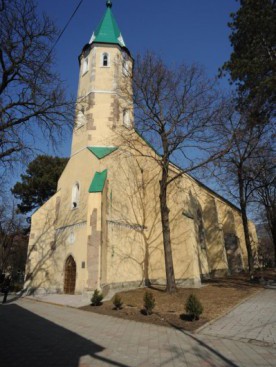The Roman Catholic parish church –Vynohrad’ivThe towns is located at the bottom of the large and high hill, called Fekete-hegy. It was the seat of one of the smallest administrative units of the Hungarian Kingdom, Ugocsa county. The town’s privileges were established by junior king Stephen V of Hungary in 1262. The importance of the settlement is also shown by the fact that its parish was under the clerical jurisdiction of the archbishop of Esztergom, not the Transylvanian bishop. Vynohrad’iv was owned by the ruler until 1399, afterwards it became the seat of the estate owned by the Perényi family. A massive fire devastated the town in 1525 and, somewhat later, the Calvinist faith spread form the 1540s onwards in Nagyszőlős. The impressive church stands in the main square. Its exterior walls have been preserved mostly in their medieval state, however, the inside suffered major modifications. Square-based buttresses were embedded in the walls of the nave and the sanctuary to support the newly constructed vaulted ceiling. The carved structures of the church are made of a tuff-like rock, probably stones quarried from the huge Fekete-hegy hill. The base of the nave is an elongated rectangle, while the sanctuary attached to its eastern end is enclosed by five sides of an octagon. The two lower levels of the tower standing in front of the western frontispiece were constructed according to a square layout, however, an octagonal layout was used for the higher levels. Buttresses reinforce the two western corners of the tower. The openings for the windows were cut in medieval times, but their frames stem from the Modern Age. No medieval details can be seen on the inside. The chancel arch separating the nave from the sanctuary is a lancet arch. On the western side of the chancel arch, near the southern and the northern pillars alike, the supporting elements of the medieval rood screen have been preserved. A sedilia subdivided into three parts had been carved out from the south-eastern wall of the sanctuary. Opposite to it, at the eastern end of the north-eastern wall, one can see a large, rectangular tabernacle carved of stone. The church was certainly built in several successive stages. The oldest parts, which have been preserved, are the three small windows of the nave’s northern wall. The sanctuary illustrates the next stage, since it appears to be a unitary part both in terms of its layout and structure. The most probable date of construction is the period between 1400 and 1435 roughly. The southern portal of the nave was carved around 1500. The present state of the church is proof of the political role played by the Perényi family, since the main stage of construction was probably the period when Péter Perényi served as the judge royal (iudex curiae regiae). During Soviet times, the church served as a storage facility; in consequence, the church furniture was destroyed. However, the place of worship has been returned to the Roman Catholic Church in 1989. |


















